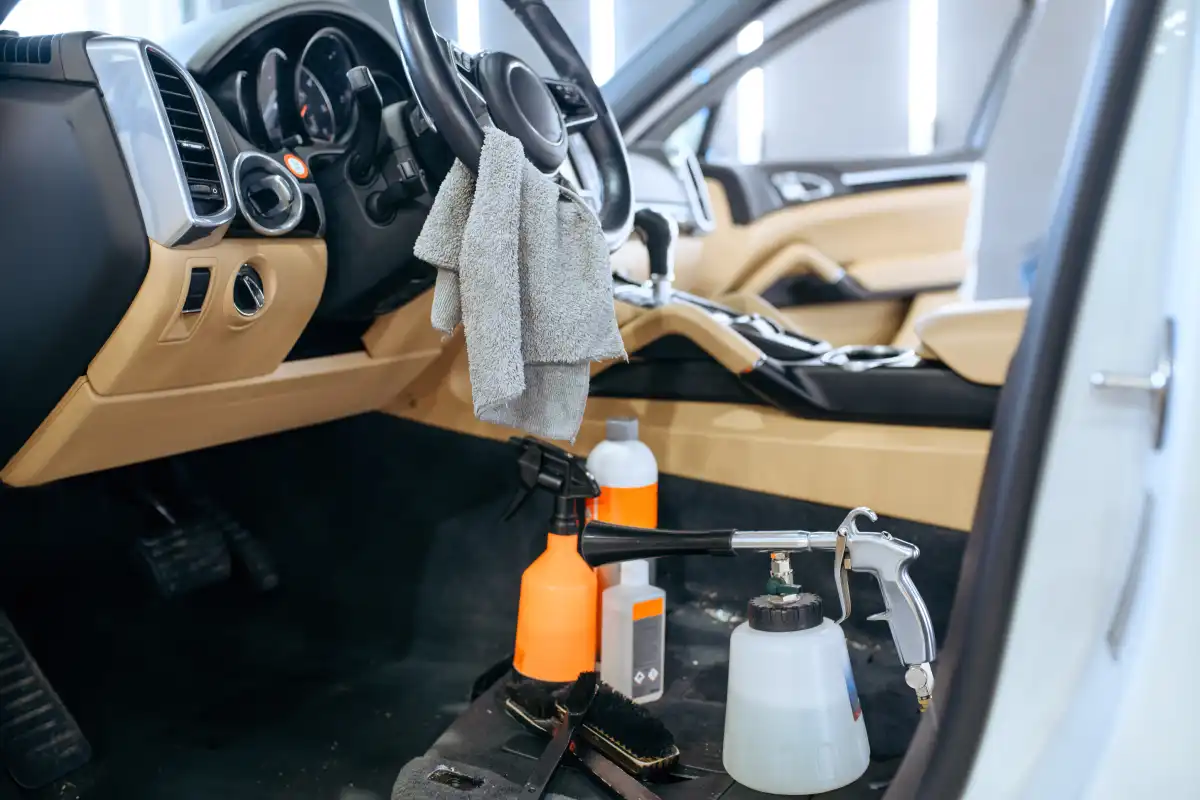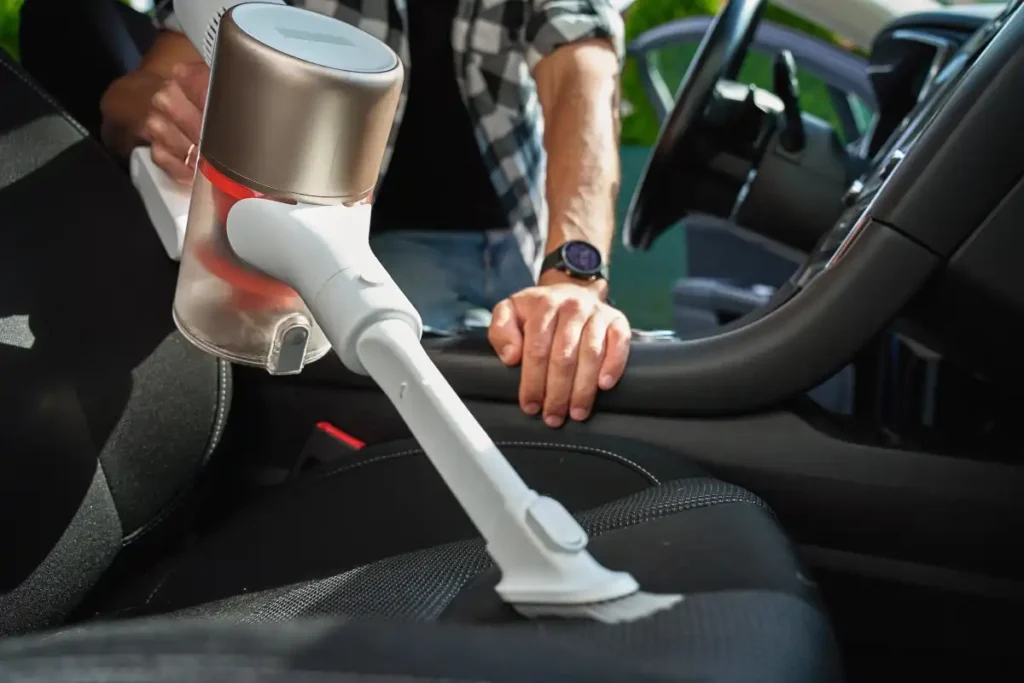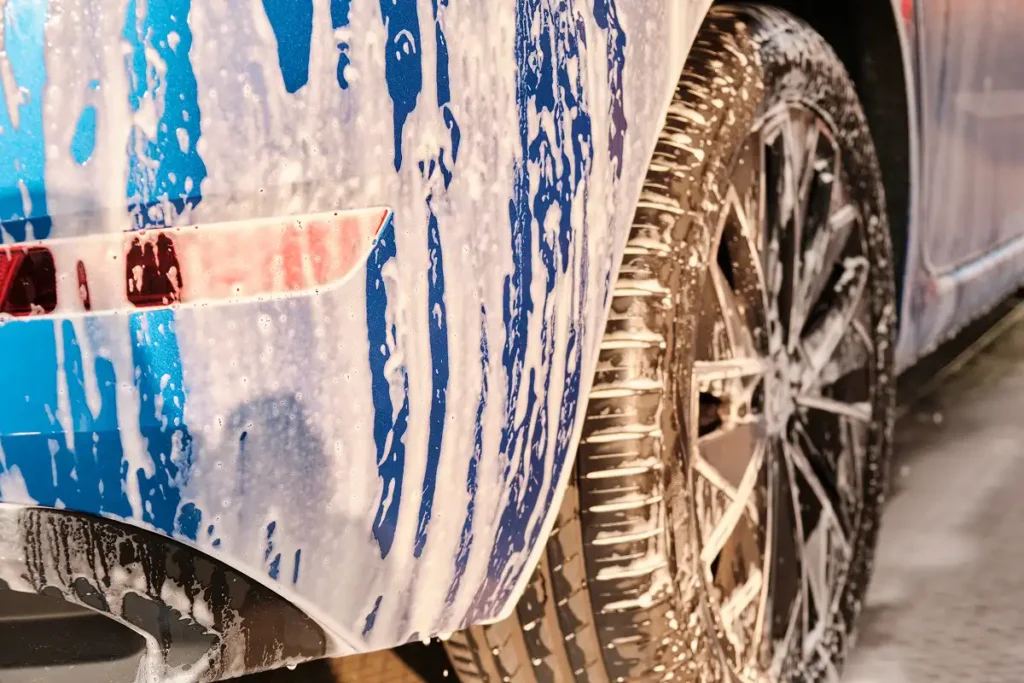
Unlike regular car wash supplies, car detailing tools are precision instruments built to protect paint, maintain upholstery, and enhance shine.
This guide covers the essential tools for every stage of detailing, how to choose the right gear for your needs, and the maintenance habits that keep your equipment lasting longer. Whether you are new to detailing or upgrading your setup, this resource helps you make informed, results-driven decisions.
Core Categories of Car Detailing Tools
The best car detailing tools are organized into a few essential categories that work together to deliver professional, long-lasting results. These represent the foundation of every well-equipped garage or mobile detailing operation. Each category plays a specific role in achieving a professional finish that lasts. By understanding and investing in these core tool groups, you build a system that delivers efficiency, protection, and unmatched results.
The following categories break down the essential tools that form the backbone of any complete detailing setup, for cleaning and protecting every surface of your vehicle.
Electric Air Dusters

Electric air dusters have become a staple in modern car detailing because they deliver precision cleaning power without the waste or limitations of canned air.
Most electric air dusters operate using either plug-in AC power or rechargeable lithium batteries, offering steady airflow that doesn’t weaken as the can empties. Their ability to deliver targeted airflow makes them invaluable for both quick touch-ups and deep interior detailing.
Why Detailers Use Electric Air Dusters
Unlike traditional drying towels or compressed air cans, electric air dusters maintain consistent airflow without moisture or chemical propellants. They’re especially useful for:
- Drying delicate areas after washing, such as mirror housings, badges, and door jambs
- Blowing away wax residue or polishing dust after paint correction
- Cleaning electronics and vents without introducing water or chemicals
- Touchless drying routines to prevent swirl marks or micro-scratches
Key Features to Look For
When choosing an electric air duster for car detailing, focus on build quality, power control, and ergonomics. Look for:
- Adjustable airflow speeds for different surfaces and materials
- Rechargeable lithium-ion battery (preferably 6000mAh or larger) or AC plug-in option
- Interchangeable attachments for various detailing angles
- Removable intake filter to prevent internal dust buildup
- Lightweight design with ergonomic grip for extended use
- Noise-reduction design for indoor or mobile detailing setups
Many professionals rely on them between detailing stages to speed up workflow and avoid re-contaminating freshly cleaned surfaces.
Explore the best electric air dusters for detailingCar Vacuum Cleaners

A quality vacuum cleaner is indispensable for interior detailing. It handles dirt, crumbs, and pet hair while helping maintain carpets and upholstery.
Modern car vacuums come in several styles, each serving a different purpose. Understanding the differences helps match the right model to your workflow and workspace.
Types of Car Vacuums
- Handheld Vacuums: Compact and lightweight, handheld units are ideal for spot cleaning and quick maintenance jobs. They fit easily between seats, inside door pockets, and around consoles. Battery-powered versions offer portability, while corded options generally provide stronger suction.
- Wet/Dry Shop Vacuums: These are the workhorses of interior detailing. They can handle both dry debris and liquid spills, making them essential for deep-cleaning carpets and fabric seats. Larger canisters and flexible hoses allow continuous cleaning without frequent emptying.
- Cordless Stick Vacuums: While more common in household use, many detailers rely on cordless stick vacuums for mobility inside garages or mobile detailing setups. Some models include interchangeable nozzles designed for automotive use.
Key Specifications to Evaluate
When comparing models, pay attention to the following features that directly influence cleaning power and ease of use:
- Suction Power: Measured in watts or air watts, stronger suction ensures effective removal of embedded dirt and pet hair. Look for a model that maintains consistent airflow even as the dust container fills.
- Airflow and Filtration: Efficient airflow design improves suction performance, while multi-stage or HEPA filters trap fine dust and allergens. Replace or clean filters regularly to prevent loss of suction.
- Capacity: A larger dustbin or tank means fewer interruptions during cleaning sessions. For professionals, a 4- to 6-gallon tank is ideal for full interior jobs.
- Noise Level: Quieter models are preferable for mobile detailing or enclosed spaces. Look for vacuums that balance noise control with performance.
Professional Tips
- Vacuum before using liquid cleaners or extractors to avoid creating mud from loose debris.
- Use short, overlapping strokes to maximize pickup efficiency.
- Empty the tank and clean filters after every detailing session.
- Inspect hoses for cracks or blockages that may reduce performance.
A reliable car vacuum is essential for achieving a truly clean, fresh interior. Investing in a powerful, versatile model delivers consistent, professional-level results for both personal and professional detailing.
Read our guide on the top-rated car vacuum cleanersFoam Cannons

For both enthusiasts and professionals, foam cannons are among the most valuable car detailing tools because they create a safer, more efficient wash process. They work on a simple but effective principle: air, water, and soap combine under pressure to produce thick, clinging foam that loosens dirt before you touch the paint.
The foam acts as a lubricant, lifting contaminants away from the surface and allowing them to rinse off gently. This pre-wash step prevents abrasive particles from grinding into the clear coat when you perform the contact wash.
Features to Consider When Buying
Pay attention to the following details when selecting a foam cannon for your detailing setup:
- Adjustable Foam Density: Look for a control knob that lets you fine-tune the soap-to-water ratio. This helps create thicker or lighter foam depending on the job.
- Durable Brass Connectors: Brass fittings resist corrosion, prevent leaks, and handle high water pressure better than plastic alternatives.
- Wide-Mouth Bottle: A larger opening simplifies refilling and reduces spills when mixing soap solutions.
- Sturdy Plastic or PET Bottle Construction: High-quality bottles resist cracking and chemical degradation from detergents.
- Quick-Connect Fittings: Allow fast attachment to pressure washer wands, saving time during setup and cleanup.
A foam cannon transforms an ordinary wash into a safer, more effective process. Its thick foam improves cleaning, protects paint, and delivers professional-level results from home.
Learn more about the best foam cannons for car detailingCar Steam Cleaners

Steam cleaners are one of the most versatile and environmentally conscious tools in car detailing. By breaking down contaminants through heat and pressure, steam cleaners allow detailers to clean and sanitize virtually every surface of a vehicle safely and efficiently.
How Steam Cleaning Works
A steam cleaner heats water to temperatures between 200°F and 300°F, producing pressurized vapor that penetrates deep into fabrics, seams, and textured surfaces. The heat loosens grime, dissolves grease, and kills bacteria and allergens. When used correctly, steam leaves behind minimal moisture, meaning surfaces dry quickly without the risk of mold or mildew growth.
The result is a deep, chemical-free clean that restores freshness to interiors while also being safe for the environment. For professional detailers, this process provides a fast and hygienic solution for clients sensitive to cleaning agents or fragrances.
What to Look for in a Steam Cleaner
Selecting the right model depends on your workflow, frequency of use, and budget. Consider:
- Heating Time: Faster warm-up reduces downtime during jobs.
- Pressure Output: Look for consistent pressure between 40 and 60 PSI for most detailing tasks.
- Water Tank Capacity: A larger tank means longer operation before refilling, which is useful for professional setups.
- Adjustable Steam Control: Allows you to fine-tune pressure for different surfaces.
- Attachment Variety: Brushes, nozzles, and microfiber heads increase versatility.
- Durability: Stainless steel boilers and reinforced hoses extend lifespan under heavy use.
Safety and Efficiency Tips
- Always test on an inconspicuous area before applying steam to delicate materials.
- Keep the nozzle moving to avoid heat damage on plastics or leather.
- Wipe surfaces immediately after steaming to lift loosened dirt.
- Regularly descale the boiler to prevent mineral buildup and maintain consistent performance.
A quality steam cleaner enhances any detailing routine by providing deep, chemical-free cleaning. It reaches tight areas, sanitizes surfaces, and delivers a precise, professional, and eco-friendly finish.
See our detailed review of the best car steam cleanersCar Squeegees
Car squeegees are an underrated but highly effective tool for drying vehicles quickly and safely after washing. Unlike traditional towels, squeegees remove large amounts of water from paint and glass in a single pass, reducing the time it takes to dry your car and minimizing the risk of water spots.
The best car squeegees are made with soft, flexible silicone blades that conform to the curves of your vehicle without scratching the surface. Many models feature ergonomic handles or water-wicking designs for improved control and comfort.
When choosing a car squeegee, consider:
- Blade Material: 100% medical-grade silicone offers the safest, most effective drying.
- Size and Reach: Larger blades cover more surface area, while compact squeegees are ideal for mirrors and windows.
- Handle Design: Non-slip grips and adjustable handles make detailing easier on hands and wrists.
Car squeegees are especially useful for:
- Post-wash drying: Speed up drying before using a microfiber towel.
- Glass cleaning: Leave streak-free windows and mirrors.
- Reducing towel use: Extend the lifespan of your drying towels by removing excess water first.
Read our guide to the best car squeegees for detailingAdditional Tools Worth Considering
Beyond the main washing, polishing, and vacuuming equipment, car detailing tools also include smaller, precision accessories that elevate the overall quality of your work. These accessories may seem secondary, but they play a critical role in achieving a flawless, swirl-free finish and maintaining the longevity of your detailing efforts. Every serious detailer, whether professional or enthusiast, should keep these essentials within easy reach.
Microfiber Towels
Microfiber towels are the backbone of safe detailing. Their ultra-fine fibers lift and trap dust, polish residue, and water without scratching delicate paint or trim. Different towel types serve distinct purposes:
- Drying Towels: Thick, high-GSM towels absorb large amounts of water quickly and minimize the risk of streaks.
- Polishing Towels: Short-pile weaves are ideal for removing wax or polish residue and buffing to a high gloss.
- Glass Towels: Tight, low-pile weaves leave a streak-free finish on windows and mirrors.
Always wash microfiber towels separately from cotton fabrics and avoid fabric softeners, which can reduce absorbency. Dedicated storage helps prevent contamination with grit or debris.
Detail Brushes
A quality set of detail brushes helps clean intricate areas that cloths or vacuums can’t reach. Soft-bristled brushes are perfect for vents, emblems, and trim, while stiffer nylon or boar’s hair brushes handle wheel lugs and textured plastics.
For best results:
- Use soft interior brushes on dashboards, buttons, and screens.
- Reserve stiffer brushes for exterior components such as badges, grills, and brake calipers.
- Clean and dry brushes after every use to prevent trapped dirt from scratching surfaces.
Clay Bars and Synthetic Clay Mitts
Clay bars are essential for paint decontamination. Even after washing, microscopic contaminants such as tar, tree sap, and industrial fallout can bond to the surface. A clay bar glides over lubricated paint and pulls out these embedded particles, creating a perfectly smooth base for polishing or waxing.
For convenience, many detailers now use synthetic clay mitts or pads, which offer faster application and easier cleaning between uses. Always follow with a protective wax, sealant, or ceramic coating after claying to preserve the finish.
Buckets and Grit Guards
A proper wash setup starts with a two-bucket method: one bucket for soapy water and another for rinsing your mitt. Adding grit guards to each bucket helps trap dirt at the bottom, preventing it from being reintroduced to the wash mitt and reducing the risk of scratches.
Sturdy buckets with ergonomic handles and tight-fitting lids are also useful for storing wash tools and keeping contaminants out between uses.
Why These Tools Matter
Each of these accessories might seem small compared to larger machines, but together they complete the detailing process. They ensure that every inch of the vehicle is treated with precision and care, from paint correction to final drying. Investing in high-quality accessories not only refines your results but also protects your tools, surfaces, and overall workflow, turning a good detail into a truly professional one.
How to Choose the Right Car Detailing Tools
Selecting the right car detailing tools depends on your skill level, detailing frequency, and budget. Here is what to consider before purchasing:
Match Tools to Your Goals
- Beginners: Start with a quality vacuum and foam cannon.
- Intermediate detailers: Add an air duster and steam cleaner.
- Professionals: Invest in commercial-grade tools with replaceable parts and higher PSI or wattage ratings.
Evaluate Build Quality
Avoid plastic-heavy designs for high-impact tools. Metal connectors and heat-resistant components typically last longer.
Check Compatibility
Ensure pressure washers, hoses, and foam cannons share compatible fittings and PSI ranges. Mismatched equipment can reduce performance.
Compare Power Ratings and Efficiency
Look for wattage, PSI (for washers), or airflow metrics (for vacuums and dusters). High specs matter, but so does ergonomics. Comfort during long use prevents fatigue.
Maintenance and Storage Tips
Proper maintenance extends tool lifespan and ensures consistent results.
- Clean tools after every use and rinse foam cannons and dry hoses.
- Store in a dry, ventilated space to prevent rust or mold.
- Descale steam cleaners periodically to maintain performance.
- Replace filters and attachments as recommended by the manufacturer.
- Inspect cords and seals for wear before plugging in electric units.
Routine care prevents expensive replacements and ensures each detailing session runs smoothly.
Tool Upgrades by Skill Level or Budget
Choosing the right detailing tools depends on your experience level and investment comfort. The difference between beginner and professional-grade tools comes down to three key factors: durability, power, and precision. Understanding these differences helps you build your detailing setup strategically, avoiding wasted money on tools that either underperform or exceed your current needs.
| Level | Power Output | Lifespan | Price Range | Ideal For |
| Beginner | Medium | 1–3 years | $50–$150 | Personal use, light cleaning |
| Intermediate | High | 3–5 years | $150–$300 | Frequent detailers |
| Professional | Very High | 5+ years | $300+ | Commercial detailing or enthusiasts |
Beginner Level: Building a Strong Foundation
For newcomers to car detailing, the goal is to start simple with dependable, easy-to-use tools that deliver noticeable results without overwhelming complexity. At this stage, affordability and learning the proper techniques matter most.
Intermediate Level: Expanding Capability and Efficiency
Once you have mastered the basics, upgrading to mid-tier tools significantly improves results and efficiency. Intermediate detailers often begin working on multiple cars or expanding into paid detailing work. Tools at this level feature stronger motors, higher pressure ratings, and better build quality, which translates to faster performance and longer durability.
Professional Level: Precision, Power, and Longevity
At the professional level, detailing becomes a refined craft that demands tools built for consistency, speed, and accuracy. Professional-grade equipment is engineered for daily use, featuring robust construction, advanced controls, and specialized attachments that support higher output without sacrificing safety or precision.
Progression Over Time
Moving from beginner to professional equipment should be an organic process. As your skills evolve, your eye for detail sharpens, and you begin to recognize the limitations of entry-level tools. Each upgrade should serve a purpose: either to save time, enhance quality, or increase efficiency.
By upgrading with intention, you create a professional setup that reflects both your expertise and commitment to quality.
How Often Should You Replace Detailing Tools?
Most car detailing tools last for years when properly maintained. However, replace them when you notice:
- Decline in pressure or suction
- Cracked hoses or seals
- Overheating during use
- Visible corrosion or leaks
Microfiber towels and brush sets should be replaced every 6 to 12 months depending on frequency of use.
Common Mistakes to Avoid
Even with the best tools, detailing can go wrong when small mistakes add up. These errors often seem harmless at first but can lead to scratches, fading, or premature wear on both tools and vehicle surfaces. Understanding what to avoid is as important as mastering the right techniques.
Using Household Towels Instead of Microfiber
One of the most frequent missteps beginners make is grabbing old bath or kitchen towels to dry or wipe down their car. Although convenient, these fabrics are too rough for automotive paint and trim. Their larger fibers and seams can leave behind swirl marks, lint, and micro-scratches that dull the finish over time.
Neglecting Pad and Filter Maintenance
Polishing pads and vacuum filters are workhorses that need consistent care. A clogged vacuum filter reduces suction power and causes motors to overheat, while dirty polishing pads can reintroduce abrasive particles onto paint surfaces. Both issues compromise results and shorten equipment lifespan.
Using the Wrong PSI with Foam Cannons
Foam cannons perform best within a specific pressure range. Too much pressure can thin out the foam, reducing its ability to cling to the surface. Too little pressure can cause uneven soap distribution and poor coverage.
Overheating Surfaces with Steam Cleaners
Steam cleaning is powerful, but it requires restraint. Holding the nozzle too close or lingering on one spot for too long can cause damage to plastic trim, upholstery, or leather surfaces. High heat can warp materials or leave behind water spots and streaks.
Final Thought
Attention to detail is what separates professional results from amateur outcomes. Avoiding these common mistakes not only protects the surfaces you are working on but also extends the life of your tools. With the right habits and maintenance, every detailing session becomes smoother, safer, and far more rewarding.